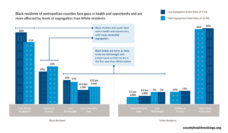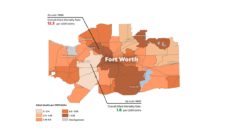Every day, new data on the Covid-19 pandemic reveals that black Americans are disproportionately likely to be infected with and die from the disease. The news is devastating but not surprising given the stark health disparities that persist across the color line in America. Of course, as it always bears repeating: it is not race but racism that drives these gross differences in health outcomes.
Social scientists have long been interested in how racism drives racial disparities in health. Early work pointed to the racial gap in health outcomes that remains after accounting for socioeconomic status (SES) as evidence of structural racism. Recently, scholars have worked to move beyond such ‘residual’ thinking to model structural racism directly using a variety of measures, including residential segregation, policy context, local political economy, incarceration, or even police involved killings.
Building on a spate of recent research linking local area economic opportunity to population health outcomes, my colleagues and I developed a new, place-based measure of structural racism we call the ‘racial opportunity gap.’ We construct this measure using race- and sex-specific data on the earnings of parents and their adult children, aggregated from Internal Revenue Service administrative records and made available by opportunity insights.
Quite simply, the racial opportunity gap captures the difference in the adult earnings of black and white children born to families at the same income level in a given county. For example, in Norfolk, Virginia, black boys born to families at the 25th national income percentile move up, on average, to the 29th income percentile in adulthood. By comparison, white boys in Norfolk born to families at the 25th national income percentile move up to the 39th national income percentile in adulthood, amounting to a racial opportunity gap of 10 points. The racial opportunity gap in Norfolk is slightly below the average of 11 points for males and 10 points for females across the more than 1,500 counties for which we have data.
Where the racial opportunity gap is higher, so too is structural racism.
As a measure of structural racism, the racial opportunity gap helps disentangle the effect of place from socioeconomic status in generating racial health disparities. As we detail in the paper, the size of SES gaps between blacks and whites in a given place are the product of multiple overlapping historical processes (of migration, of segregation, of deindustrialization, of exclusion). Given these historical determinants, the size of these SES gaps can’t be taken as a proxy for the degree of structural racism in a place. By capturing differences in the adult economic outcomes of black and white children who started at the same income level, the racial opportunity gap better reveals how race interacts with structural features of a place to shape life chances. Where the racial opportunity gap is higher, so too is structural racism.
Across counties in the US, we find that the size of the racial opportunity gap is positively and significantly associated with the size of the racial mortality gap, a summary measure of racial health disparities. The association remains robust even after accounting for racial gaps on a range of socioeconomic measures, including poverty, unemployment, median income, and education.
The racial opportunity gap offers one framework for modeling the underlying and often obscured effect of place in generating racial disparities in economic and health outcomes. What drives the racial opportunity gap — be it differential school quality, housing patterns, or criminal justice policy — varies across localities. Delineating the policies, institutions, and other factors associated with economic opportunity and upward economic mobility will, by extension, generate new insights into the structural determinants of racial health disparities.
The racial opportunity gap measure has several important limitations; for one, lack of data currently prevents us from measuring change over time. Nevertheless, we hope this measure and analytic framework proves useful in efforts to identify and mitigate the effects of structural racism on population health.














